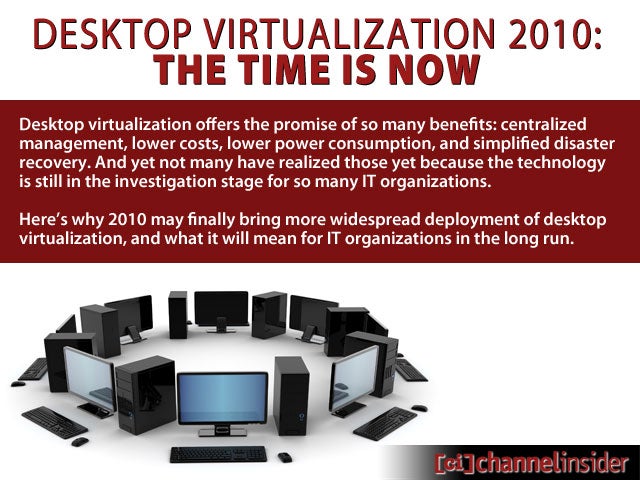 Desktop Virtualization 2010 The Time Is Now
Desktop Virtualization 2010 The Time Is Now
Desktop Virtualization 2010: The Time Is NowDesktop virtualization offers the promise of so many benefits: centralized management, lower costs, lower power consumption, and simplified disaster recovery. And yet not many have realized those yet because the technology is still in the investigation stage for so many IT organizations. Here’s why 2010 may finally bring more widespread deployment of desktop virtualization, and what it will mean for IT organizations in the long run.
 No Title
No Title
Thin Client Gets Full-FeaturedLate last year VMware introduced VMware View 4.0, which offers that PC-over-IP protocol. This product will allow IT to provide each user their familiar PC desktop that doesn’t look anything like the thin clients of the past.
 No Title
No Title
Better Data SecurityIn the age of thin clients, gone are the days when corporate data is only as secure as each corporate laptop you have out in the field. Centralized data means the end to headaches caused by lost laptops.
 No Title
No Title
Increased User ProductivitySystem crash? Instability? No problem. We’ll just give redeploy that virtualized desktop to you. In seconds. No need to take that laptop to IT, re-image it, reload applications. Here’s the OS, apps and your personal preferences, rebuilt in an instant.
 No Title
No Title
Lower Support CostsCentralized management means even fewer desk-side visits. Patches, upgrades, and troubleshooting can all be performed centrally. Just as cost cutting served as a catalyst for server virtualization and consolidation, as IT looks at client replacements, cost cutting and TCO concerns will make desktop virtualization more attractive.
 No Title
No Title
More User FlexibilityYou would think with all that centralized control that users would have to give up much of their flexibility and freedoms. But there’s so much gained. For example, a user can access his or her virtualized desktop from his thin client at work or from his personal PC at home, or from the PC at the client he or she is visiting this week. IT can even allow users to choose their own clients.
 No Title
No Title
Disaster RecoveryDR is not just about the server anymore. Client downtime has previously meant your employees’ productivity ground to an expensive halt. But now, workers can go home and access their desktops from their personal machines. And once it’s all back up and running, the virtual desktops can be instantly deployed again at the worksite.
 No Title
No Title
Where’s It All Going?Forrester Research: “The revolution will take years, but virtualization is the future of the corporate PC.” Forrester predicts the revolution will begin this year.
 No Title
No Title
Some Vertical Industries Already On The WayFor example, many traditional call centers are already using desktop virtualization. Many finance departments, contractors and software developers are also already using desktop virtualization, too, according to Forrester Research.
 No Title
No Title
Proving Business Value To Customers Will Get EasierVendors recognize that in spite of the benefits, the move to desktop virtualization represents a major shift for most IT organizations. So they are working to develop more total cost of ownership (TCO) calculators to help organizations justify investments in the technology.

